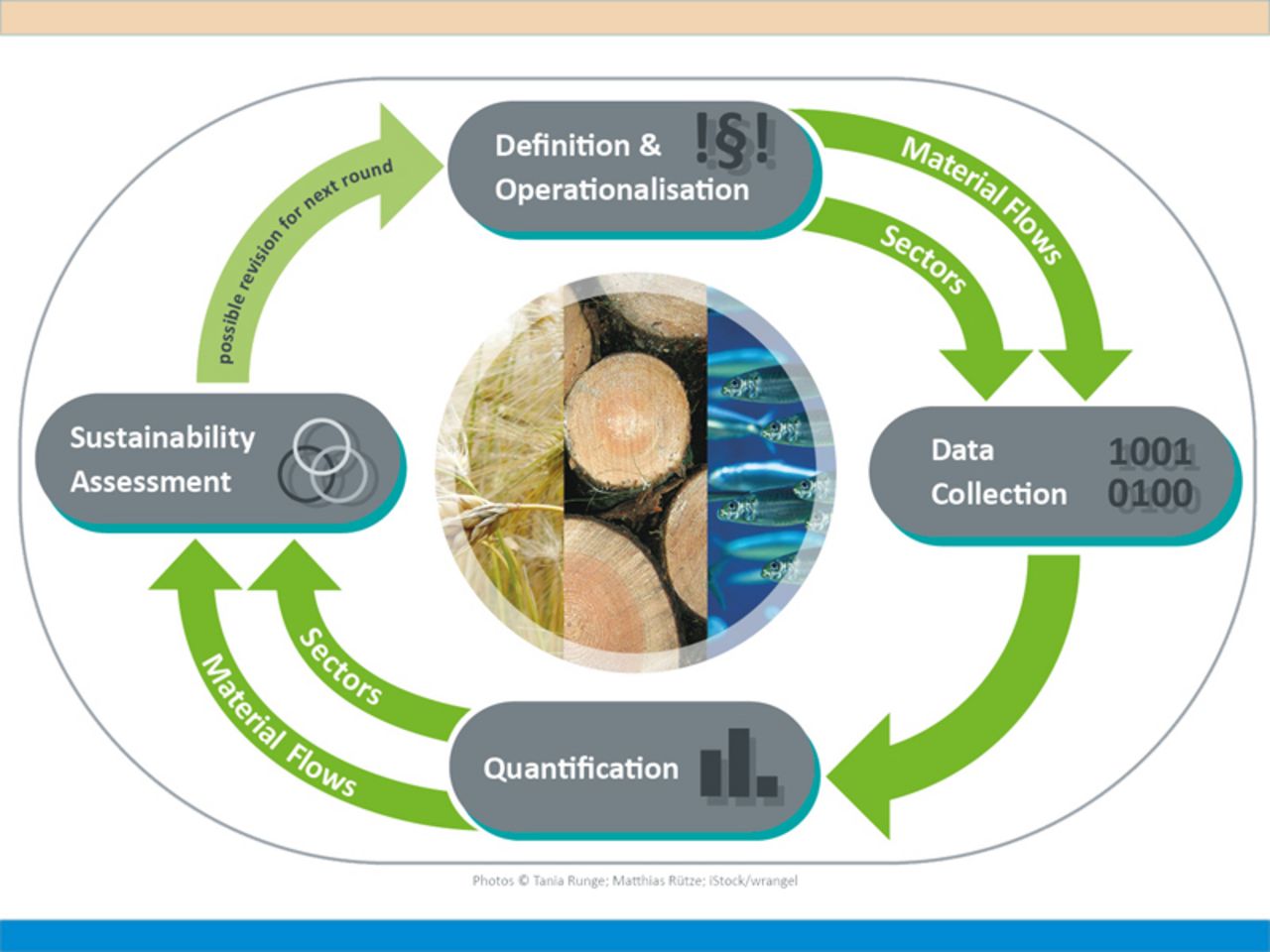Project
Bioeconomy Monitoring II

Development of a systematic bioeconomy monitoring - Consolidation Phase
· What has biomass use in Germany developed?
· How important are import commodities for German bioeconomy and what effects do they have in the countries of origin?
· We will address these and further questions in the project.
Background and Objective
In the 1st phase of the establishment of a systematic bioeconomy monitoring, we created the methodological basis for the quantification of the bio-based resource base, associated sustainability effects and carried out an initial monitoring. In this project, we want to further develop and supplement the methodological concept.
With regard to the monitoring of the bio-based resource base, we want to link residual material and by-product flows with agricultural, forestry and fisheries material flows in order to demonstrate the extent and efficiency of residual material and cascade use. In addition, we want to extent the monitoring and quantify major import commodities such as soy, pulp or meat and trace them back to their origin.
Complementary to the quantification of import commodities we aim to quantify and assess sustainability effects associated with major import commodities in their countries of origin. As a best practice example we will show for commodities from Uruguay that a complementary bioeconomy monitoring approach in exporting countries provides useful information to differentiate between more sustainably produced and less sustainably produced commodities.
Approach
In detail, we want to proceed as follows:
- Linking bio-based with residue material flows
- Monitoring of substitution effects, cascade use, resource efficiency
- Monitoring of import commodities
- Best practice examples for the identification and quantification of more or less sustainably produced import commodities
- Updating material flow analyses
- Updating quantification of material flow based and sectoral sustainability effects
Data and Methods
The main data base for sectoral and material flow quantifications are data and results used in and derived during the first bioeconomy monitoring period. Additionally, we use updated official statistics, empirical and market observation studies.
For identification of biomass imports we apply the Forward-Tracing method and we will further develop and improve it.
For evaluating resource efficiency, substitution effects and cascade uses we screen the existing literature. Based on the screening results we develop definitions, indicators and methods which are applicable in long-term monitoring.
Our Research Questions
- How has biomass use developed in Germany?
- How big is the bioeconomy in Germany?
- Which import commodities are of highest importance for German bioeconomy and which effects have imports at their counrties of origin?
- How can we measure resource efficiency, substitution effects and cascade use?
Thünen-Contact

Involved Thünen-Partners
- Banse, MartinMA Institute of Market Analysis
- Barrelet, JohnaSF Institute of Sea Fisheries
- Bösch, MatthiasWF Institute of Forestry
- Brüning, SimoneSF Institute of Sea Fisheries
- Döring, RalfSF Institute of Sea Fisheries
- Gordillo, FernandoWF Institute of Forestry
- Iost, SusanneWF Institute of Forestry
- Kilian, DavidMA Institute of Market Analysis
- Omidi Saravani, FaranakWF Institute of Forestry
- Omidi Saravani, FaranakWF Institute of Forestry
- Pozo Inofuentes, PaolaWF Institute of Forestry
- Sturm, ViktoriyaMA Institute of Market Analysis
- Weimar, Holger WF Institute of Forestry
Involved external Thünen-Partners
- Deutsches Biomasseforschungszentrum (DBFZ)
(Leipzig, Deutschland) - Deutsches Biomasseforschungszentrum (DBFZ)
(Leipzig, Deutschland)
Funding Body
-
Fachagentur Nachwachsende Rohstoffe e.V. (FNR)
(national, öffentlich)

Publications to the project
- 0
Ronzon T, Gurria P, Carus M, Cingiz K, El-Meligi A, Hark N, Iost S, M'Barek R, Philippidis G, van Leeuwen M, Wesseler J (2024) Assessing the bioeconomy's contribution to evidence-based policy : A comparative analysis of value added measurements. Bio-Based App Econ 13(4):317-331, DOI:10.36253/bae-14563
- 1
Beck-O'Brien M, Bringezu S, Banse M, Barrelet J, Bezama A, Bösch M, Brüning S, Bührlen B, Cabezas A, Cyffka K-F, Dzene I, Gordillo Vera F, Helander H, Henke J, Hennenberg K, Iost S, Kilian D, Pozo Inofuentes PS, Schweinle J, Weimar H, et al (2024) Monitoring der deutschen Bioökonomie - Zusammenfassung : Status, Leistung, Trends und Auswirkungen auf eine nachhaltige Entwicklung. Kassel: Center for Environmental Systems Research (CESR) ; Universität Kassel, 21 p, DOI:10.17170/kobra-2024111510678
- 2
Beck-O'Brien M, Bringezu S, Banse M, Barrelet J, Bezama A, Bösch M, Brüning S, Bührlen B, Cabezas A, Cyffka K-F, Dzene I, Gordillo Vera F, Helander H, Henke J, Hennenberg K, Iost S, Kilian D, Pozo Inofuentes PS, Schweinle J, Weimar H, et al (2024) Monitoring the German bioeconomy - Summary : Status, performance, trends and implications for sustainable development. Kassel: Center for Environmental Systems Research (CESR) ; University of Kassel, 21 p, DOI:10.17170/kobra-2024111510677
- 3
Beck-O'Brien M, Bringezu S, Banse M, Barrelet J, Bezama A, Bösch M, Brüning S, Bührlen B, Cabezas A, Cyffka K-F, Dzene I, Gordillo Vera F, Helander H, Henke J, Hennenberg K, Iost S, Kilian D, Pozo Inofuentes PS, Schweinle J, Weimar H, et al (2024) Monitoring the German bioeconomy : Status, performance, trends and implications for sustainable development. Kassel: Center for Environmental Systems Research (CESR) ; University of Kassel, 193 p, DOI:10.17170/kobra-2024111510679
- 4
Pozo Inofuentes PS, Bösch M, Schweinle J (2024) Monitoring the sustainability of the EU biomass supply: A novel hybrid approach combining tracing and selected sustainability impacts. Land 13(9):1366, DOI:10.3390/land13091366
- 5
Brüning S (2023) 27% Selbstversorgung auf deutschem Markt : Warenstrom Hering und Heringserzeugnisse im Jahr 2021. Fischmag(5):44-46
- 6
Ronzon T, Iost S, Philippidis G (2022) An output-based measurement of EU bioeconomy services: Marrying statistics with policy insight. Structural Change Econ Dynam 60:290-301, DOI:10.1016/j.strueco.2021.10.005
- 7
Ronzon T, Iost S, Philippidis G (2022) Has the European Union entered a bioeconomy transition? Combining an output-based approach with a shift-share analysis. Environ Dev Sustain 24(6):8195–8217, DOI:10.1007/s10668-021-01780-8
- 8
Pozo Inofuentes PS, Boscana Goires M, Schweinle J (2022) Monitoring the sustainability effects of bioeconomy beyond black and white perspectives: The forest sector in Uruguay : [paper for] XV World Forestry Congress, Coex, Soul, Republic of Korea, 2-6 May 2022. 7 p
Duration
11.2021 - 10.2024
More Information
Project funding number: 2221NR062A
Funding program: FNR
Project status:
finished




